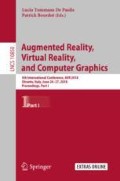Abstract
In the fields of Augmented Reality (AR) and Virtual Reality (VR), Human-Computer Interaction (HCI) is an important component that allows the user to interact with its virtual environment. Though different approaches are adopted to meet the requirements of individual applications, the development of efficient, non-obtrusive and fast HCI interfaces is still a challenge. In this paper, we propose a new AR and VR interaction interface based on Human Action Recognition (HAR) with a new binary motion descriptor that can efficiently describe and recognize different actions in videos. The descriptor is computed by comparing the changes in the texture of a patch centered on a detected keypoint to each of a set of patches compactly surrounding the central patch. Experimental results on the Weizmann and KTH datasets show the advantage of our method over the current-state-of-the-art spatio-temporal descriptor in term of a good tradeoff among accuracy, speed, and memory consumption.
Access this chapter
Tax calculation will be finalised at checkout
Purchases are for personal use only
References
Khotimah, W.N., Sholikah, R.W., Hariadi, R.R.: Sitting to standing and walking therapy for post-stroke patients using virtual reality system. In: International Conference on Information and Communication Technology and Systems (ICTS), pp. 145–150 (2015)
Sieluzycki, C., Kaczmarczyk, P., Sobecki, J., Witkowski, K., Maśliński, J., Cieśliński, W.: Microsoft Kinect as a tool to support training in professional sports: augmented reality application to Tachi-Waza techniques in judo. In: Third European Network Intelligence Conference (ENIC), pp. 153–158 (2016)
Tao, G., Archambault, P.S., Levin, M.F.: Evaluation of Kinect skeletal tracking in a virtual reality rehabilitation system for upper limb hemiparesis. In: International Conference on Virtual Rehabilitation (ICVR), pp. 164–165 (2013)
Choi, J., Cho, Y.I., Cho, K., Bae, S., Yang, H.S.: A view-based multiple objects tracking and human action recognition for interactive virtual environments. IJVR 7(3), 71–76 (2008)
Yeffet, L., Wolf, L.: Local trinary patterns for human action recognition. In: IEEE 12th International Conference on Computer Vision, pp. 492–497 (2009)
Kliper-Gross, O., Gurovich, Y., Hassner, T., Wolf, L.: Motion interchange patterns for action recognition in unconstrained videos. In: Fitzgibbon, A., Lazebnik, S., Perona, P., Sato, Y., Schmid, C. (eds.) ECCV 2012. LNCS, vol. 7577, pp. 256–269. Springer, Heidelberg (2012). https://doi.org/10.1007/978-3-642-33783-3_19
Whiten, C., Laganiere, R., Bilodeau, G.A.: Efficient action recognition with MoFREAK. In: International Conference on Computer and Robot Vision (CRV), pp. 319–325 (2013)
Baumann, F., Ehlers, A., Rosenhahn, B., Liao, J.: Recognizing human actions using novel space-time volume binary patterns. Neurocomputing 173, 54–63 (2016)
Blank, M., Gorelick, L., Shechtman, E., Irani, M., Basri, R.: Actions as space-time shapes. In: Tenth IEEE International Conference on Computer Vision (ICCV), vol. 2, pp. 1395–1402 (2005)
Schuldt, C., Laptev, I., Caputo, B.: Recognizing human actions: a local SVM approach. In: Proceedings of the 17th International Conference on Pattern Recognition, vol. 3, pp. 32–36 (2004)
Al-Berry, M.N., Salem, M.A.M., Ebeid, H.M., Hussein, A.S., Tolba, M.F.: Fusing directional wavelet local binary pattern and moments for human action recognition. IET Comput. Vis. 10(2), 153–162 (2016)
Acknowledgment
This work is supported by the CAS-TWAS Presidents Fellowship, the National Natural Science Foundation of China (Grant No. 61371192), the Key Laboratory Foundation of the Chinese Academy of Sciences (CXJJ-17S044), and the Fundamental Research Funds for the Central Universities (WK2100330002, WK3480000005).
Author information
Authors and Affiliations
Corresponding author
Editor information
Editors and Affiliations
Rights and permissions
Copyright information
© 2018 Springer International Publishing AG, part of Springer Nature
About this paper
Cite this paper
Fangbemi, A.S., Liu, B., Yu, N.H., Zhang, Y. (2018). Efficient Human Action Recognition Interface for Augmented and Virtual Reality Applications Based on Binary Descriptor. In: De Paolis, L., Bourdot, P. (eds) Augmented Reality, Virtual Reality, and Computer Graphics. AVR 2018. Lecture Notes in Computer Science(), vol 10850. Springer, Cham. https://doi.org/10.1007/978-3-319-95270-3_21
Download citation
DOI: https://doi.org/10.1007/978-3-319-95270-3_21
Published:
Publisher Name: Springer, Cham
Print ISBN: 978-3-319-95269-7
Online ISBN: 978-3-319-95270-3
eBook Packages: Computer ScienceComputer Science (R0)

